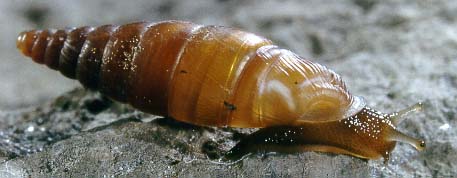
| Gastropoda: Pulmonata |
||
| Mollusca | Pulmonata |
Heterobranchia
└─► |
|||
None |
Mollusca |
|
Abbreviated Dendrogram
Gastropoda
├─Caenogastropoda
└─Heterobranchia
├─Opisthobranchia
│
└─Pulmonata
╞═Basommatophora
└─┬─Stylommatophora
└─┬─Systellommatophora
╘═Acteophila
|
Contents
Overview |

Pulmonates are the third of the traditional sub-classes of gastropods. They include the only terrestrial molluscs. are also the only subclass of the three that can confidently be considered a monophyletic clade, although their ancestry (whether from Heterostropha or Opisthobranchia, or even "Prosobranchia" (which latter would apply a degree of parallelism with the Opisthobranchia)) is still debated.
The Pulmonates differ from the "Prosobranchs" by detorsion and symmetrical concentrated nervous system, primitively loss of gills and a mantle cavity converted into a lung for gas exchange with air (or secondarily breathing water) and (with only exception) lack of an operculum. They also are hermaphroditic, each individual having two sets of sex organs. [Barnes 1980 p.338, 377]
The shell may be external, internal, vestigial (as in the land slug Testacella), and in a number of lineages has disappeared absent altogether (e.g. terrestrial slugs). If external, the shell is often thin, and the morphology is typically conispiral and rather bulbous, although a few aquatic forms [Planorbis, etc] have a planispiral shell; which is unusual in modern gastropods.
Pulmonates have adapted to a wide range of environments. Many are terrestrial or live in freshwater (pond, swamp or river) environments. While most common in temperate and tropical areas, some species are found in deserts and mountains. Some forms readapted to water and again populated freshwater and marine habitats, others are confined to land.
The pulmonate body type and life habits is defined by the problem of how to conserve water and prevent desiccation (drying up). A major part of the solution was to seal off the mantle (pallial) cavity. This one innovation greatly reduced evaporative water loss. The mantle cavity is vascularized and lined with blood vessels for gas exchange, becoming a lung, and a single narrow passage, the pneumostome, provides access to the exterior [Barnes 1980 p. 338, Chase 2002 p.13 ].
Behaviors include the ability to retreat into the shell and drastically reduce metabolic activity during dry periods (aestivation), although shell-less forms (slugs) frequent moist environments.
It is not known whether Pulmonates evolved from terrestrial or freshwater ancestors, but the fact that both Heterostropha and Opisthobranchia include almost only marine forms, and the Siphonaroid limpets retain a veliger larva, would indicate the latter. It is speculated that they evolved from ancestral forms inhabiting estuarine marshes and mud flats, the pulmonate condition having evolved a s a means of gas exchange when the animals were confined to small stagnant puddles during the dry season [Barnes 1980 p.338]. Pulmonates first appear during the Jurassic period. [Clarkson, 1979 p.163] earlier forms now known to be terrestrial prosobrancha
Taxonomists typically divide the Pulmonata into at least three orders (sometimes superorders [Barnes 1980 p.377], the Basommatophora, Stylommatophora, and a small apparently primitive group of uncertain relationships, Systellommatophora.
Cladistic analysis has modified this picture somewhat. Jeffery 2001 divides the clade Eupulmonata into three branches, the Acteophila, Trimusculiformes, and Stylommatophora. Each are given the Linnaean rank of infraorder, in order to fit the whole hierarchy into a cladistic perspective. However it is my contention that the Linnaean ranks shouldn't be made to fit the cladistic tree (or vice-versa). So as the Stylommatophora are traditionally of ordinal rank, the same should go for the Acteophila (which would seem to be equivalent to Salvini-Plawen 1980's order Archaeopulmonata ) and Trimusculiformes.
Vaught 1989 includes the Trimusculidae (a group of marine limpets) with the Siphonariidae in the Siphonarioidea (Order Basommatophora), but if placed there this would make the taxon paraphyletic. The Trimusculiformes includes only the superfamily Trimusculoidea and the family Trimusculidae Zilch, 1959
The trail of the Snail - non-technical introduction to Pulmonates (snails and slugs). Includes list of superfamilies and description of selected families and species (with illustrations) A-K and L-Z - best on the web
Pulmonates - short intro
Pulmonates (Air Breathing Land Snails) some information on Pulmonata and terrestrial Prosobranchia. Includes a classification by Abbott & Dance, 2000 which is different from the one used here
page uploaded 25 February 2003,
last modified ATW060227
checked ATW050720
original material by M. Alan Kazlev all other material © original authors or sources